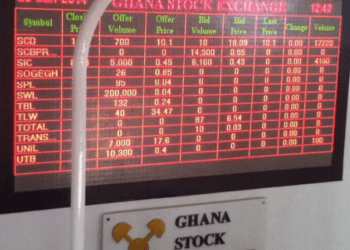The Ghanaian Government has exceeded expectations by raising GHS 4.91 billion through its Treasury Bill issuance, surpassing the initial target of GHS 3.67 billion.
This achievement signals a resurgence in investor trust in government securities amidst evolving market conditions which saw the government missed its target in the previous auctions.
The oversubscription of GHS 1.24 billion underscores the resilience of government securities, demonstrating their attractiveness to investors once again despite fluctuations in the economic landscape.
Meanwhile, despite marginal reductions in yields across the 91-Day, 182-Day, and 364-Day tenors, investor appetite remained robust.
Of particular note was the significant interest in the 91-Day Bill, followed by the 182-Day and 364-Day Bills. Successful bids amounted to GHS 3.82 billion, GHS 822 million, and GHS 272 million, respectively.
Yields experienced slight declines, with the 91-Day and 182-Day Bills settling at 25.19% and 27.39%, reflecting reductions of 25 and 40 basis points compared to the previous auction. Conversely, the yield for the 364-Day Bill remained steady at 27.99%.
In the intervening time, the Treasury aims to raise GHS 3.18 billion in the forthcoming auction, indicating sustained investor interest in government debt instruments.
The successful issuance of T-Bills and its oversubscription further solidify the Government’s ability to steer through financial challenges with confidence.
Investor Appetite and Market Dynamics
The recent success of the Ghanaian Government in exceeding its Treasury Bill issuance target sheds light on the resurgence of investor appetite amidst evolving market dynamics.
This surge in demand comes at a time when global economic uncertainties have prompted investors to seek safe-haven assets like T-bills which are less riskier. Ghana’s stable political environment and ability of the government to pay it’s local debt in the short end of the market have further bolstered investor confidence, making government securities an attractive investment option.
Furthermore, the composition of successful bids across different T-Bill tenors provides insights into market sentiment. The substantial interest in the shorter-term 91-Day Bill suggests that investors are prioritizing liquidity and short-term returns. On the other hand, the steady demand for the longer-term 364-Day Bill indicates a desire for secure investment options with relatively higher yields.
Despite the overall positive outlook, market dynamics continue to evolve, influencing investor behavior and government securities’ performance. Factors such as changes in interest rates, inflation expectations, and global economic conditions can impact investor sentiment and T-Bill yields.
Yield Trends and Investment Strategies
The recent performance of Ghana’s Treasury Bill market has sparked discussions on yield trends and investment strategies among market participants.
One notable trend is the marginal decline in T-Bill yields across various tenors, including the 91-Day, 182-Day, and 364-Day Bills. This reduction in yields, albeit modest, was aimed at reducing government’s interest accrued on its borrowings.
While lower yields may indicate decreased returns for investors, they also signal a shift towards lower-risk assets in uncertain economic environments.
Investors are closely monitoring these yield trends to adjust their investment strategies accordingly. For some, the decline in T-Bill yields may prompt a reassessment of portfolio allocations, with a focus on diversification and seeking alternative investment opportunities. Others may view the current yield levels as attractive, especially in comparison to other investment options with higher risk profiles.
Additionally, the composition of successful bids across different T-Bill tenors provides insights into investors’ investment horizons and risk preferences. The strong demand for shorter-term T-Bills suggests a preference for liquidity and capital preservation, while the steady interest in longer-term T-Bills reflects a desire for higher yields and income stability.
In response to these yield trends, investors are exploring various investment strategies to optimize returns while managing risk. Some may adopt a “barbell” approach, combining short-term T-Bills for liquidity with longer-term bonds or equities for potential higher returns. Others may employ a “ladder” strategy, diversifying investments across multiple T-Bill tenors to mitigate interest rate risk and maintain a consistent income stream.
In the short term, the evolution of yield trends will continue to shape investors’ decisions and portfolio strategies. As market conditions fluctuate, investors will need to remain vigilant, adapt their strategies, and seize opportunities in Ghana’s dynamic Treasury Bill market.
By staying informed and agile, investors can capitalize on emerging opportunities while safeguarding their portfolios against potential risks.
READ ALSO: World Bank Boosts $138.5 Million Electricity Project in Namibia























